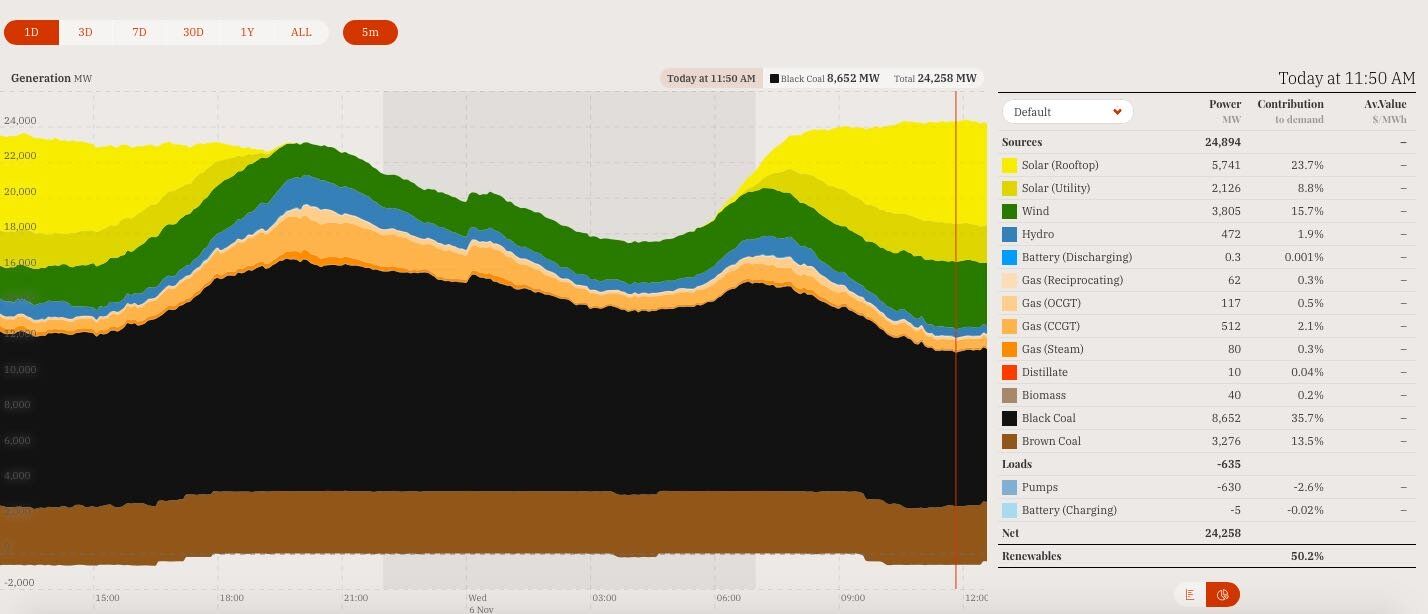Wednesday 6th of November will be remembered as a landmark day in Australia’s energy history as 50.2% of the electrons flowing on the main grid for a measured 10 minute period supplied by renewable sources.
Data from Energy Transition Hub’s OpenNem widget (see above chart) shows that rooftop solar was the largest renewable contributor with over 2 million residential and commercial systems generating 23.7 per cent of the power.
In second place was wind generating 15.7 per cent, followed by the nations large-scale solar farms at 8.8 per cent and finally hydro power contributing the remaining 1.9 per cent.
The moment has been covered by RenewEconomy’s Giles Parkinson as Solar Choice MD Angus Gemmell shared the notable achievement via the above screenshot in a text message.
For those in the industry, or those who have put solar on their homes and businesses, it is a rewarding milestone and worth taking a moment to appreciate the progress that has been around the nation.
- Why a big battery could be cheaper than a small battery with the federal rebate? - 19 June, 2025
- Heat Pump Costs – Solar Choice Price Index - 1 June, 2025
- Solar Panel Costs: Solar Choice Price Index | July 2025 - 1 June, 2025

The idea is small scale at-receiver power generation and storage. We have millions of acres of existing rooftop space, not to mention the potential of window solar voltaic cells. This completely eliminates issues of real estate and transmission loss – each of which also exists for the current coal ‘solution’.
Statistics can tell any story depending how the author pens them! Great, we can generate 50% of the nations load by renewables (solar) – DURING THE DAY!!!!!
A sunny day at that! THis may be a milestone but there is a really long way to go before any solar or wind system combined can replace 24/7 coal or nuke generation.
What erks me, as a technical electronic engineer, with many year experience in solar systems for communication stations for example, is the total absence of a sound technical analysis of how exactly a vast solar/wind system is going to work. Problems are, just to name the obvious ones, real estate for the arrays, transmission line (loss) from remote array fields (they have to be remote because they will be so large), transmission line cost, battery efficiency (it is way too low at present to be viable), battery cost, at present the cost is horrendous. Then add real estate for transmission lines, real estate for the arrays and what medium is to be used for transmission? AC?? DC?? Solar to AC requires inverters of huge capacity (cost??), Solar to DC similarly, high cost voltage converters to say 750kV, lower loss yes but the cost!!!!
come on all you advocates of solar system, ask the hard questions and get some answers, at present there is far too much philosophical rhetoric and not enough engineering realty.